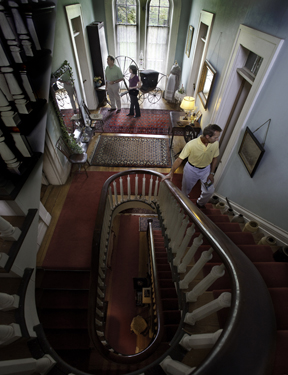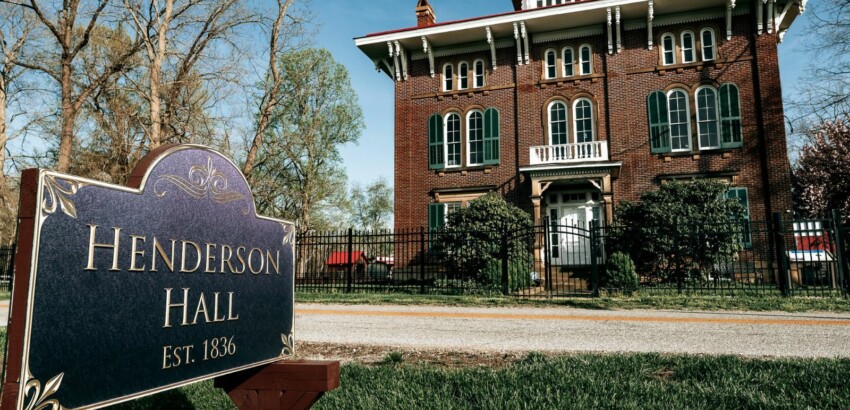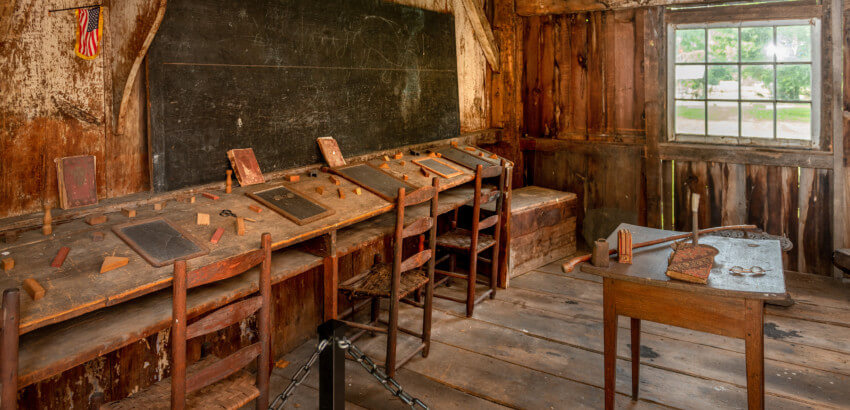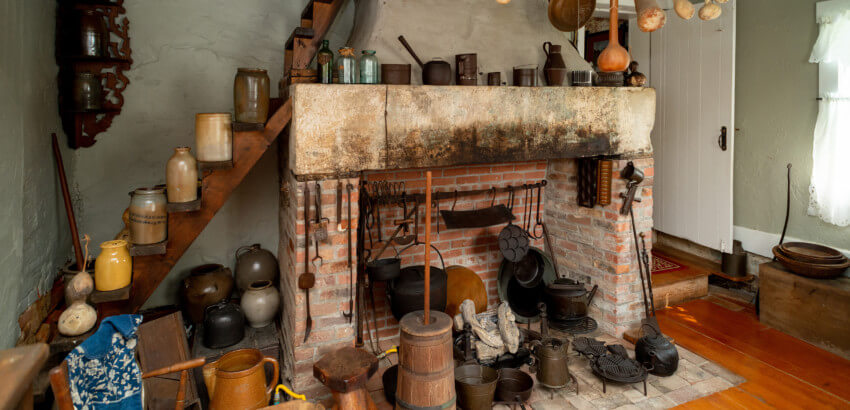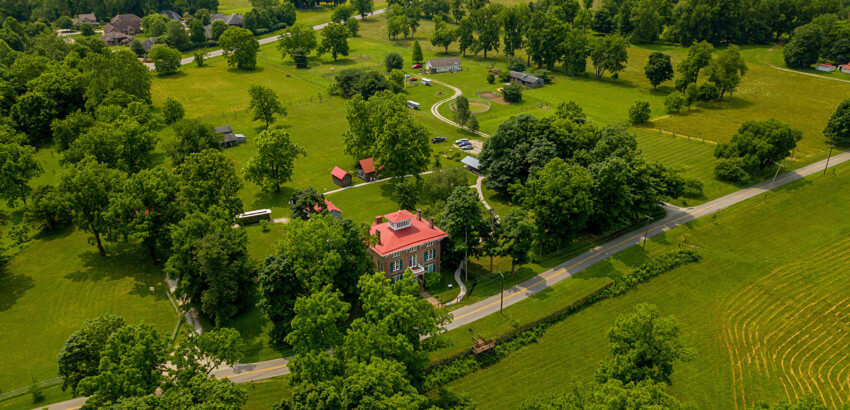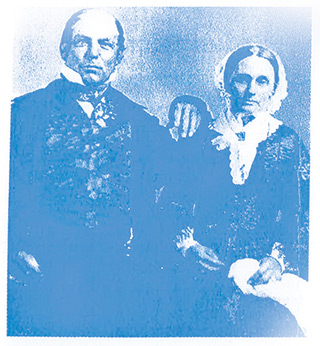
G.W Henderson and Ann Tomlinson
History
Henderson Hall
Henderson Hall is listed on the National Register of Historical Places as a historic district unto itself. It offers a view of the early American Victorian Era. The hall is 8,000 square feet with 21 rooms and was the centerpiece of the original 2,600 acres along the Ohio river.
Clan progenitor, Scottish-born Alexander Henderson Sr. arrived in Virginia in the 1700s serving in the House of Burgesses and as a member of the committee appointed to decide boundary lines that still exist today between Maryland and Virginia. Henderson counted such historic icons as Thomas Jefferson, James Madison, James Mason and George Washington among his acquaintances. It was on advice of his friend George Washington, that Henderson bought 25,000 acres in western Virginia, and sent three of his sons to the then wilderness that was the Mid-Ohio Valley.
Henderson brothers Alexander and John played a key role in thwarting the treasonous exploits of Aaron Burr. The brothers turned in Harman Blennerhassett and Burr when Blennerhassett tried to recruit the Henderson’s to become part of Burr’s scheme. The Henderson’s reported the plot to family friends President Jefferson and Secretary of State Madison and alerted local militia. In the archives of Henderson Hall is a letter from Dumfries native John Graham, who was dispatched by Jefferson to investigate Burr’s activities, thanking the Henderson’s for the integral part they played in foiling Burr’s plot.
G.W. Henderson married Elizabeth Ann Tomlinson. Educated at Ohio University, G.W. studied law at Marietta College and served at the 1861 Wheeling Convention. G.W. remained loyal to the Union during the Civil War even though the family had slaves and the family in Virginia joined the Confederacy. G.W. built what is today Henderson Hall.
The 29-room perfectly preserved Victorian-era Italianate style River Road Henderson mansion which stands on a terrace overlooking the Ohio River was completed in 1859 using brick, stone and timber from the Henderson property.
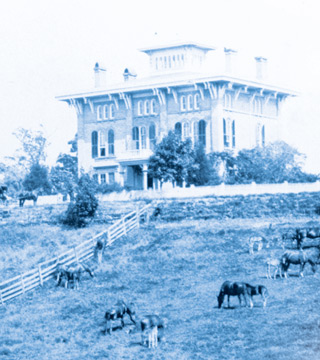
The Grounds
The house, grounds and Henderson family cemetery is designated the Henderson Hall Historic District and is listed on the National Registry of Historic Places.
Following in the footsteps of his Scottish forebears whose clan motto was “Virtue alone ennobles,” family member Brevet Brigadier General Archibald Henderson served as the 5th Commandant of the Marine Corps, one of the longest serving Marine Corps commandants and technically the first American-born commandant. He served a stint on the U.S.S. Constitution during the War of 1812. The U.S.S. Henderson was named for him as is Henderson Hall Barracks in Arlington, Va. His long tenure earned him the nickname “Grand Old Man of the Marine Corps.” He commanded the military escort for the burial of William Henry Harrison and was a pallbearer at the funeral of longtime friend Dolly Madison.
Another family member, Thomas Henderson was a well-known military doctor and minister in the Episcopal Church. He penned the first written manual on medicine for the Department of the Army in 1820-1830, and he, along with Francis Scott Key, started the first Episcopal Church in Georgetown.
The last living Henderson ancestor, Michael Rolston died in 2007 bequeathing Henderson Hall to the Oil and Gas Historical Association which is overseen by a board of directors to assure its preservation.
The Legacy
The Henderson legacy is a national treasure.
ADMISSION
Adults: $15.00
Veterans: $10.00
Children: $10.00
Tour Groups over 10 people: $10
Open April – December
12:00pm – 5:00pm
Wednesday-Sunday
The home contains priceless artifacts, antiques and furnishings right down to handmade linens, books dating back to the 1600s, documents signed by the likes of Patrick Henry, then governor of Virginia; local ballots from the Lincoln-Douglas presidential election, diaries, a letter written by Robert E. Lee to Elizabeth Henderson. Some of the documents may literally rewrite history.
Family records describe a duel between one of the family members and another local pioneer, making it the only duel ever recorded north of the Ohio River.
There is a letter dated 1861 from Burning Springs where Rolston’s great-grandfather ran a riverboat store with details of a battle at Burning Springs, which could mean it was actually the second battle of the Civil War in West Virginia.
Brothers Jock Bedell; Henry Clay, who served both in the House of Delegates and State Senate, and Arthur Taylor Henderson operated the family farm, which included cows, sheep, chickens, turkeys, peafowl, and a multitude of crops. In addition, doing business as the Henderson Brothers they ran a nationally known Standard Trotting horse breeding and boarding business for about 30 years. Horses with the bloodlines from two of their prize studs, Sacramento and Nutguard can still be found today in trotters. The Henderson’s received requests for their stock catalogue from as far away as Canada and Paris, France.
Buildings on the estate grounds include what is believed to be the first schoolhouse in Wood County, possibly the oldest in the state; an 1826 carriage, and a 100-year-old still which the Henderson brothers used to make homebrew.
There are three Adena pre-historic Indian mounds on site.
John James Audubon and John Chapman, better known as Johnny Appleseed, the legendary frontier missionary/nurseryman were among many of the well-known visitors to the plantation. A direct descendant of Chief Justice John Marshall who presided over Burr’s treason trial also enjoyed tea during a visit to Henderson Hall.
– Pam Brust, Henderson Hall historian/research assistant.
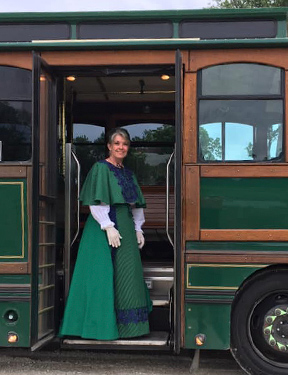
Ride aboard the Valley Gem Sternwheeler and Henderson Hall Trolley from Marietta to Henderson Hall homestead and back!
517 Old River Road
Williamstown, WV
304.375.2129
